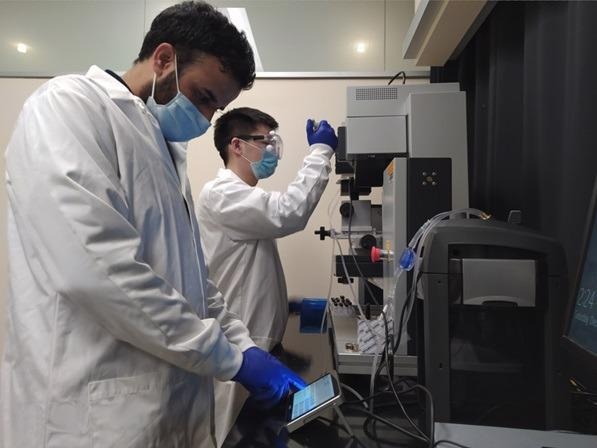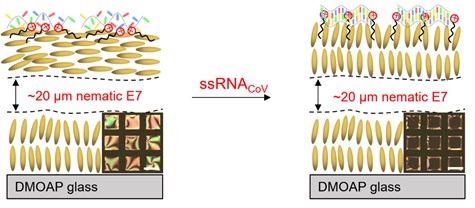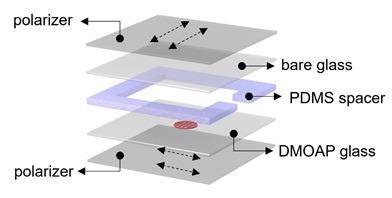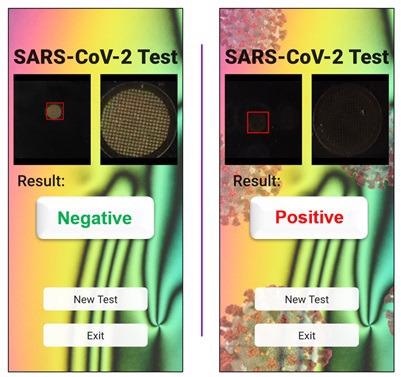The worldwide pandemic COVID-19 has urged scientists around the world to concentrate their research on the virus. Some focused on understanding the fundamental aspects of the virus and its transmission, while other efforts were directed towards vaccine creation or therapeutic development.
In order to diagnose individuals infected with the virus as quickly as possible after many initiated the search for rapid and robust tests that could be handed out to a significant proportion of the population.
In this article Xiaoguang (William) Wang, Ph.D. - recently appointed Assistant Professor in the William G. Lowrie Department of Chemical and Biomolecular Engineering, College of Engineering at the Ohio State University (OSU), USA – discusses the exploration surrounding his recent pioneering work in the field of SARS-CoV2, specifically the development of a rapid detection method for the SARS CoV-2 virus that utilizes a liquid crystal (LC) sensor.
A Call to Action: The Need for New Testing Technology
During the early stages of the pandemic, researchers moved in the direction of developing testing protocols for this new and mysterious virus. Groups with various specialties fixed their gaze on SARS-CoV2 testing and how they could modify or pivot their research to confront this global issue.
Tests using reverse-transcription polymerase chain reaction (RT-PCR) – the gold-standard for molecular clinical diagnostics – were readily available. However, these tests need extended periods and specialized equipment to perform characterization.
A range of other technologies have demonstrated promise as potential diagnostic tools. For example, gold nanoparticles and column agglutination test (CAT), but each has considerable limitations. The demand for rapid, easy-to-use, and effective techniques to detect and identify the virus emerged.
Professor Wang and the team at OSU answered the call of the challenge to develop a rapid detection method for the SARS CoV-2 virus utilizing a liquid crystal (LC) sensor.
Prof. Wang speaks of his decision to regard LCs as a potential diagnostic technology: “It is commonly known that thermotropic LCs have been employed for the detection of various biomolecules, including DNA and lipids, for example. However, I know of no reports where they have been used for the detection of RNA. So, we set out to apply the technique to SARS-CoV-2 RNA.”
Since 2016, Professor Wang has co-authored more than 20 publications providing the research community with insights into the design of novel dynamic materials and systems based on colloidal and interfacial phenomena.
This knowledge forms the basis of a novel class of stimuli-responsive materials for use in a wide range of applications such as pharmaceuticals and biosensors.

Adil and Yang, members of Prof. Wang’s group at OSU, working with the Linkam temperature control setup in the lab. Image Credit: Linkam Scientific Instruments Ltd.
The focus of my research looks to address the question of how polymer chain architecture affects the deformation behaviors of shape-changing polymers. Results obtained from this work will provide new design principles for responsive polymeric materials for soft robotics. In addition, I am particularly interested in anisotropic liquid-infused surfaces, which permit manipulation of surface wettability and slipperiness by using physical, chemical or biomolecular events. I believe we can open entirely new routes for designing advanced surfaces that may find use in, for example: water harvesting, drug delivery and biological sensors.
Prof. Wang, Ph.D., Ohio State University
Using Thermotropic Liquid Crystals for Viral Detection
Liquid Crystals demonstrate characteristic and predictable behavior due to their long-range orientational order and the flexibility of their mesogenic constituents.
They have been extensively used in rapid-switching electro-optical devices, including liquid crystal displays (LCDs). Their ever-growing use in sensing applications is due to their self-assembly and ordering characteristics and potential for tunable stimuli-responsive properties.
Professor Wang’s team at Ohio State University initiated a joint effort with Prof. Xiaoping Bao at Purdue University for the development of biosensors for SARS-CoV-2 and Prof. Rongjun Qin at OSU for the design of a smartphone app for automated readout of the ssRNA of SARS CoV-2.
Outlining the goals of the project, Prof. Wang stated, “LCs are ultrasensitive to small chemical modulations, and different analytes can be detected at extremely low concentrations. Therefore, taking advantage of the high-sensitivity of liquid crystals, we felt that we could develop a rapid detection method for the SARS CoV-2 virus that would not need any sophisticated equipment and infrastructure. Moreover, we set out to design a portable and economical LC-based sensor detection kit for the rapid detection of ssRNA of the virus.”
Over the past ten years, a series of key works have disclosed the design of LC films and droplets that experience orientational ordering transitions in response to a variety of molecules adsorbed at an interface.
For instance, single-stranded DNA (ssDNA) and double-stranded DNA (dsDNA) generate varying orientations of LCs at cationic surfactant-laden aqueous-LC interfaces, which results in a change in the effect on visible light because of the optical birefringence of the LC film.
A Proof of Concept
To demonstrate that ssRNA from the virus showed the same property and that LCs were viable for detection of COVID-19, Prof Wang’s group used a 4-step experimental program.
Step 1. Preparation of a cationic surfactant dodecyltrimethylammonium bromide (DTAB)-decorated interface on micrometer-thick films of a commercially available nematic liquid crystal, ‘E7’ prepared.
The layers were propped-up on a dimethyloctadecyl[3-(trimethoxysilyl) propyl]ammonium chloride (DMOAP)-functionalized glass slide, which prompted a perpendicular ordering of the E7.
Step 2. An ssDNA probe, with a sequence complementary to the defined SARS-CoV-2 ssRNA target, was adsorbed at the DTAB-decorated aqueous-E7 interface. Through electrostatic interactions, the negatively charged ssDNA is attracted to the cationic DTAB at the aqueous-E7 interface.
Step 3. ssRNACoV was introduced to the DTAB-laden E7 surface with the adsorbed ssDNA probe. The system’s temperature was then increased to 48.7°C, which is the Tm of the ssRNACoV. A Linkam PE120 Peltier hot stage was put in place to control the E7 surface temperature during these measurements.
Step 4. Using images captured by a CCD camera on a polarized microscope, quantification of the optical appearance (i.e., brightness) of the RNA-adsorbed E7 films was done.
Prof Wang summarized the success of these early experiments, stating, “Our work has shown that LC-based sensors offer a highly sensitive, reproducible and robust method of detection of target ssRNAcov – and we could establish the detection limit of the E7 surface for the target ssRNA by varying the concentration from nanomolar to femtomolar amounts.”
Figure 1 displays a schematic illustration of the optical response of the DTAB/ssDNAprobe-decorated LC film to the adsorption of ssRNAcov.

Figure 1. Schematic showing the physical arrangement of LCs – left shows alignment pre-addition of ssRNAcov; right shows the change in alignment induced by the binding of the ssRNAcov target to the ssDNA probe. Note: the insert image captures show the visual change from occluded (left) to clear (right). Image Credit: Linkam Scientific Instruments Ltd.
Prof. Wang identified the many advantages provided by the Linkam PE120 stage to detect the ssRNAcov target: “The PE120 gave us not only the precise and reproducible temperature control we needed, but it was also very straightforward to integrate with our microscope and other equipment. The touch display on the controller made it easy and smooth to work with. Moreover, the Linkam stage is highly portable and can be transferred from one lab to another.”
Besides the ongoing work, the group at OSU utilizes the PE120 for management and observation of the temperature-dependent phase transitions of liquid crystals. Furthermore, the polymerization of reactive liquid crystal mixtures at a distinct temperature range is also carried out with the Linkam stage.
Building a Sensor – Smartphone Detection of the Target ssRNA
Having established the principle of sensor structure and detection performance, the group began to prepare a final sensor design (Fig. 2) that incorporated polarizing layers to facilitate detection of the confirmation change in the LCs by visible light.
Additionally, the sensor device was combined with a retaining clip and suitable smartphone app to enable consistent illumination of the sensor. This allows non-expert users to rely, read, and act upon the results of a test (Fig. 3).

Figure 2. Exploded diagram to show the layered make-up of the putative diagnostic device, the LC sensor is show as a dark red spot on the DMOAP glass layer. Image Credit: Linkam Scientific Instruments Ltd.

Figure 3. A smartphone screenshot indicating a negative result (left) and positive result (right). Image Credit: Linkam Scientific Instruments Ltd.
Looking Ahead
The next immediate step for the COVID-19 work is to transition the test into a clinical evaluation phase – testing in a biosafety level 3 (BSL-3) laboratory with real patient samples.
However, the pandemic has resulted in restricted access to the labs throughout, and the group has not been able to conduct those studies to date.
Assuming satisfactory results of the subsequent stage and finalization of the validation of the system in its practical application, Prof. Wang hopes to broaden the collaboration, including the diagnostics industry for additional studies and commercialization, stating, “We are optimistic that when the current phase of the pandemic is over and work in the labs is resumed normally, an LC-based test could be in the market in the relatively near future.”
When Prof. Wang was asked about other fields that this methodology could be deployed, he added: “I believe that this prototype of ‘LC sensor combined with smartphone App’ can be used for the detection of a wide variety of biomolecules and toxic compounds in the near future.”
Comprehensive experimental protocols, results, and a discussion of the value of this work has been recently published here.
For further information regarding Linkam’s PE120 Peltier system, visit https://www.linkam.co.uk/pe120
About Professor Xiaoguang (William) Wang
Xiaoguang (William) Wang, PhD received his first-class honors and master’s degrees in chemical engineering in China before relocating to the University of Wisconsin-Madison, USA, in 2016 to complete a PhD with Prof. Nicholas Abbott. His research focus was on liquid crystal-templated assembly of colloids and molecules.
Recently, Prof. Wang was appointed Assistant Professor in the William G. Lowrie Department of Chemical and Biomolecular Engineering, College of Engineering at the Ohio State University (OSU), USA – exploring his recent pioneering work in the field of SARS-CoV2.
Prior to joining OSU, Prof. Wang worked alongside Prof. Joanna Aizenberg at Harvard University as a postdoctoral fellow, researching the design of functional materials predicated on stimuli-responsive soft matter.
The William G. Lowrie Department of Chemical and Biomolecular Engineering at OSU has around 23 tenure-tracked faculty members working across an extensive range of diverse research fields including bioengineering, catalysis, energy, fluid mechanics, molecular simulation, polymers, and sustainability.
About Linkam Scientific Instruments
A Linkam PE120 Peltier stage was a key element in the experimental set-up of this project. The stage is designed to deliver precision control of the temperature of microscope slides to +/-0.1°C from ‑25°C to 120°C.
Linkam provide market-leading solutions in optical DSC and thermodynamic sample characterization as well as hot stage and freeze-drying microscopy.
The company develops and manufactures a wide variety of temperature and environmental control stages that assist in the determination of materials including biological tissue, pharmaceutical compounds, polymer composites, fibers, nanomaterials, metals, and minerals.
Add thermal sample control from high (1500°C) to cryo-temperatures as well as alternatives for humidity, vacuum, gas purging, and electrical connections.
Linkam stages are utilized with light microscopes and a variety of analytical techniques including FTIR, Raman, WAX/SAX and many more to characterize and visualize the properties of materials.
Each one of Linkam’s instruments has been developed and manufactured in-house by a team of vastly experienced electrical, software, and mechanical design engineers. Alongside a standard range Linkam offers bespoke solutions, working in close alliance with the researcher to design, prototype, and manufacture a custom-made system.
References
- Y. Xu, A. M. Rather, S. Song, J.-C. Fang, R. L. Dupont, U. I. Kara, Y. Chang, J. A. Paulson, R. Qin, X. Bao, X. Wang. “Ultrasensitive and Selective Detection of SARS-CoV-2 Using Thermotropic Liquid Crystals and Image-Based Machine Learning”, Cell Reports Physical Science 2020, 1:12. https://doi.org/10.1016/j.xcrp.2020.100276

This information has been sourced, reviewed and adapted from materials provided by Linkam Scientific Instruments.
For more information on this source, please visit Linkam Scientific Instruments.